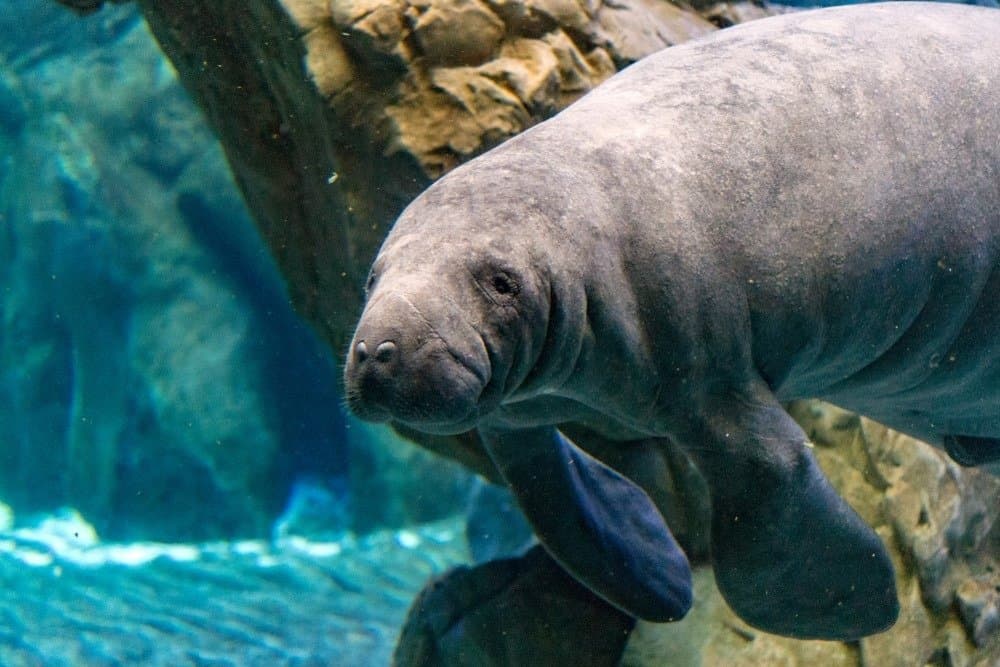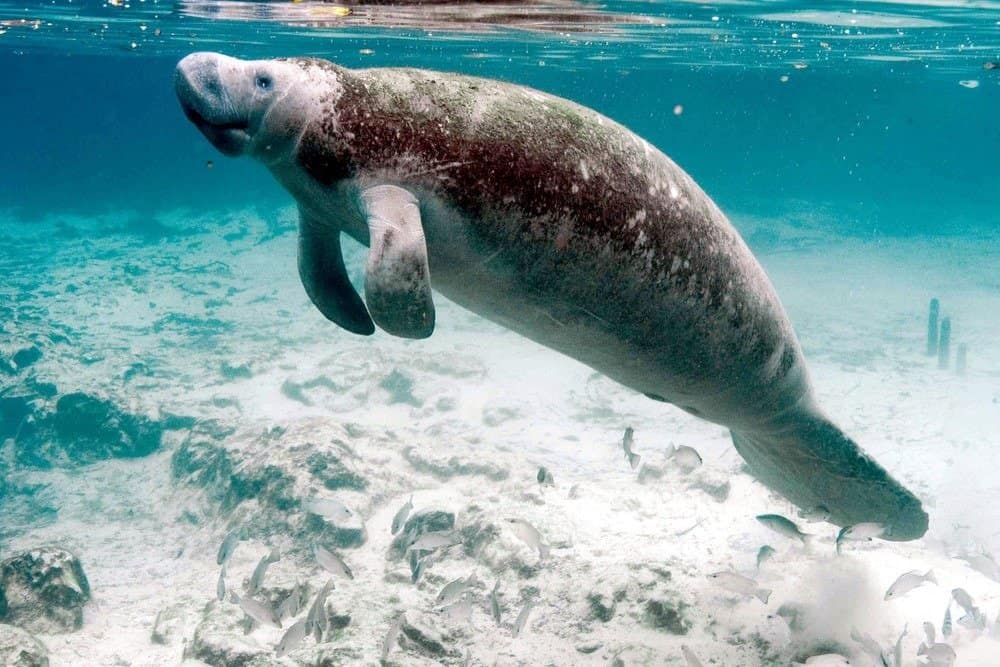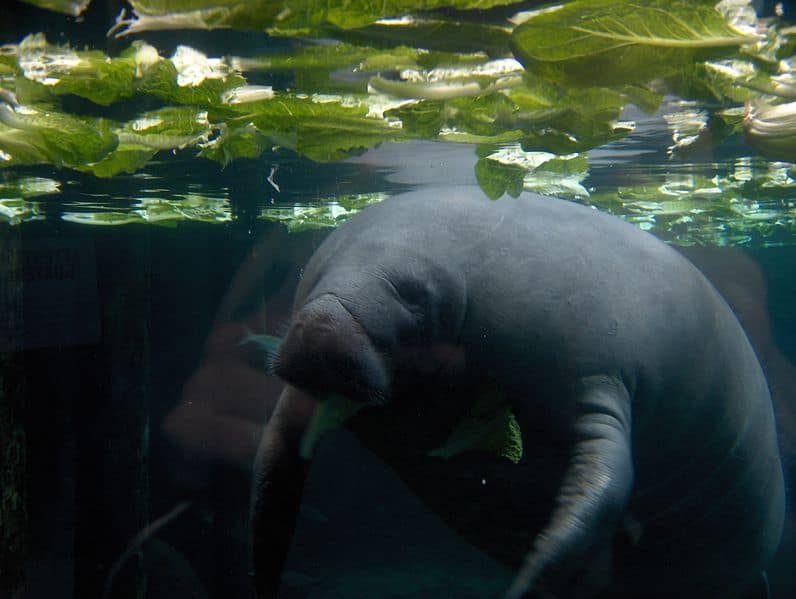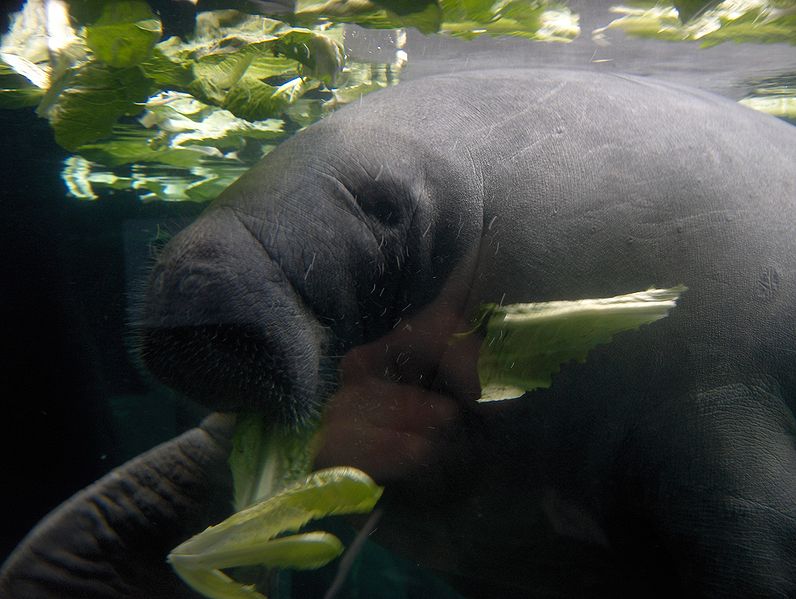If you saw a large, gray sea creature swimming right at you, you might be alarmed. You may immediately think it is a shark. If the animal had a rounded head instead of a snout full of sharp teeth you could relax a little, it is probably a manatee. But is a 10-foot, 1,000-pound manatee dangerous? Do manatees attack people? Can manatees bite? Are manatees dangerous? Let’s find out here!
What is a manatee?

Manatees are slow-moving
sea animals
that have flippers as their front feet.
©Andrea Izzotti/Shutterstock.com
Manatees are heavy, slow-moving sea animals that have a flat, round tail and two front flippers. Their faces are blunt-tipped with two black eyes that look too small for their bodies. Most are gray or brown but can appear greenish because algae often grow in patches on their backs. There are three species of manatee and two subspecies.
- West Indian Manatee
- Florida Manatee: averages 10 feet but can range from 8-13 feet and weighs up to 1,350lbs. It lives along the coast of Florida and when it is warmer further up the coast.
- Antillean Manatee: similar in size as the Florida manatee, lives in lagoons, rivers and estuaries (they are a fresh water animal) of eastern Mexico and down to the Greater Antilles Islands.
- West African Manatee: similar in size as the Florida and Antillean manatee, lives in coastal areas and rivers along the west coast of Africa.
- Amazonian Manatee: smaller than the other manatees, largest ones reach 9 feet, darker in color and have a white patch on their stomachs. Only live in fresh water and found in Brazil, Columbia, Ecuador, and Peru.
Are manatees dangerous?

Manatees are not dangerous, they actually seem to like humans!
©Ramos Keith, U.S. Fish and Wildlife Service / public domain – License
No, manatees are not dangerous. They are gentle giants that actually seem to like humans. They frequently swim up to people to seek their attention.
You may have seen a picture of a manatee seemingly “standing up” in the water almost like it wanted to be at eye level. This position is one reason early sailors reported seeing mermaids. The legend has it that manatees are probably what sailors around the world were actually seeing.
Do manatees attack people?
Manatees do not attack people. Shark attacks are rare but they do happen and sharks, especially the great white shark are aggressive. But slow-moving manatees do not attack. They don’t even attack their prey because they are herbivores and only eat vegetation. They graze like cows which is why they are sometimes called “Sea Cows”.
Do manatees bite?
Manatees have teeth but they don’t bite. They can’t bite based on the configuration of their teeth – all their teeth are molars for chewing seagrass and vegetation.
Do manatees knock over kayaks or SUP’s?
You might think these large animals could surprise a kayaker or flip someone’s SUP, but manatees are not aggressive and do not try to tip over people’s boats. There are many tour groups that purposefully take kayakers and others out to look for manatees.
Are manatees dangerous in freshwater?

Freshwater manatees live in lakes and rivers. They eat the vegetation that grows near the surface.
Freshwater manatees are not dangerous. The Amazonian manatee lives only in freshwater and swims in lakes, rivers, and streams. They frequently will feed near the surface of the water which makes them easy to hunt. People hunt them for their meat, skin, and oil. So humans are actually dangerous to manatees! The Amazonian Manatee is considered “Vulnerable” by the IUCN.
Can mother manatees get dangerous when they protect their young?

Mother manatees nurse their calves for one to two years.
©iStock.com/stammphoto
Are manatees dangerous when protecting their young? One of the instances that you might come across an angry manatee is if you came across one with its young.
Baby manatees depend on their mothers for a long time – they are nursed for a year to two. Manatees have a slow reproductive rate and only have one calf at a time every two to five years.
Do male manatees get dangerous during mating season?
During mating season, male manatees will form a herd of 6-12 males and follow one female. They have been observed competing with each other to become the first to mate with the female, but they do not fight like crocodiles or hippos, who sometimes fight to the death. Multiple males will get to mate with each female with one succeeding in producing a calf about a year later.
What do manatees do all day?

Manatees can spend 7 hours a day grazing and eating! Another 12 hours is spent sleeping.
Manatees eat and sleep! Not very exciting but they sleep about 12 hours a day. They can sleep underwater for periods of time and they sometimes sleep on their backs with their nose holes poking through the water for air.
Another 7 hours a day is spent grazing and eating! Manatees eat seagrass, pickerel weed, water lettuce, and other vegetation. They use their flippers to scoop up vegetation and bring it to their mouths to take bites, similar to humans. Each day, manatees need to eat 10-15% of their body weight to maintain their bodies.
Are humans dangerous to manatees?
Yes, humans are manatees’ biggest threat. It’s for this reason that manatees are listed as Vulnerable or Endangered by the IUCN.
- West Indian Manatee
- Florida Manatee (Vulnerable)
- Antillean Manatee (Endangered)
- West African Manatee (Vulnerable)
- Amazonian Manatee (Vulnerable)
Besides being hunted for their meat, skin, and oil, manatees can be killed by large boats. Boat strikes, as they call them, can cause injuries and death in a variety of marine life including manatees. Conservationists look at the migration patterns of marine animals to determine if boating routes need to be altered at certain times of the year.
Manatees can also get tangled in fishing nets and box traps, causing them to drown. They can hold their breath for a long time, up to 20 minutes, but if they are unable to surface, they will die. Fishing nets can also make them unable to forage for food and they can die of starvation. Ensuring fishermen use proper care to remove old equipment and checking the status of their nets will keep more manatees safe.
The photo featured at the top of this post is © A Cotton Photo/Shutterstock.com
Thank you for reading! Have some feedback for us? Contact the AZ Animals editorial team.







